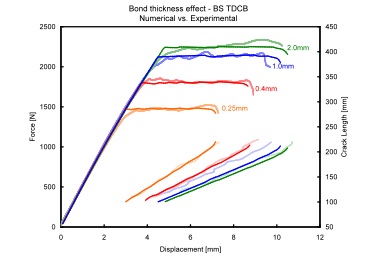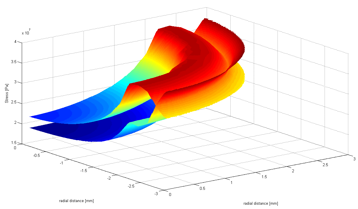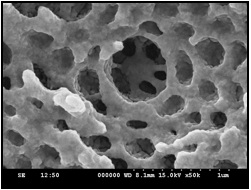Characterisation of Traction-Separation Laws in Structural Adhesives
Research
- CCM-bond
- Bacterial Adhesion
- Fracture Toughness Characterisation of Structural Adhesives
- Continuum Damage Models for Toughened Epoxy Adhesives
- An Investigation of Composite-to-Composite Bonding
- Characterisation of Traction-Separation Laws in Structural Adhesives
- Science and Engineering of Advanced Composites (SEAC)
- Research Facilities
- Collaborators
- Research Vacancies
- Mixed Mode
- CompSim
The accurate and efficient determination of the adhesive fracture toughness, GIC, and the associated fracture mechanisms of a structural adhesive are of fundamental importance to both adhesive manufacturers and end users alike. Although many testing methods and procedures have been standardised and are used to characterise adhesive fracture toughness, the accurate transfer of laboratory results to complex structures remains an uncertainty.
The current work investigates the mode I fracture behaviour of a nano-toughened, structural epoxy adhesive manufactured by Henkel using low rate TDCB tests with various bond gap thicknesses ranging from 0.25mm to 2.5mm. Two TDCB setups were used: (i) Steel substrates of 25.4mm width and (ii) 10mm wide aluminium substrates. Both configurations gave similar values of adhesive fracture energy, GIC, for a given bond gap thickness. The average value of GIC was found to increase from 2.5 kJ/m2 at 0.25 mm bond gap thickness to 5.8 kJ/m2 at 1.3 mm, and remained constant for larger bond gap thicknesses.
In parallel to this work, circumferentially deep-notched tensile (CDNT) specimens were employed in an attempt to directly characterise the local separation laws of the adhesive. A novel experimental procedure was developed, tested and numerically modelled. Experiments were carried out using specimens with various ligament to bulk area (LBA) ratios and hence a variable level of constraint/triaxiality. By matching the constraint factor, H, between the CDNT and TDCB specimens the uniqueness, and hence the geometrical transferability of the fracture parameters was demonstrated.

Figure 1: Constraint factor, H, in a CDNT specimen.
Numerical modelling of the TDCB and CDNT experiments was performed using the finite volume (FV) numerical method with a cohesive zone model (CZM). The bond gap thickness effect on fracture toughness which was observed in the TDCB tests was reproduced numerically only when a value of GIC corresponding to a given bond gap thickness and a cohesive strength, σmax, corresponding to the ultimate tensile strength (UTS) of the adhesive, was used. In order to show transferability between the CDNT and TDCB results, the TDCB experiments were successfully re-simulated using the experimental value of GIC as before (see Figure 2), and instead of using a fixed value of σmax i.e. UTS, a value of σmax as a function of H from the CDNT results was used. Also, 3D TDCB numerical simulations showed no evidence of plastic zone development in the plane strain region of the adhesive layer. It can only be seen close to the free surface i.e. in the plane stress region, indicating that the damage is localised in the small process region ahead of the crack tip.

Figure 2.
A detailed analysis of the fracture surfaces, using scanning electron microscopy (SEM), revealed variations of the microstructural features with bond gap thickness/constraint. Using the Rice and Tracey void growth model to analyse the size of the voids on the fracture surfaces, and combining this with the numerical evidence given above, the source of dependency of GIC with constraint was explained.

Figure 3: SEM image of cavitation caused by nano particles.
Finally, TDCB experiments carried out at a range of crosshead speeds (0.2 mm/min - 13.5m/s) were simulated numerically using the FV method. This work formed part of a collaborative study carried out with Imperial College London (ICL). The experimental program was conducted at ICL and the numerical program at UCD. Good agreement was achieved between the numerical predictions, analytical results and the experimental observations over the entire range of loading rates investigated. Numerical simulations were able to predict the stick-slip crack propagation, occurring between 0.1 m/s and 4.5 m/s, only when a particular crack speed-dependent CZM was used.
Sponsors:
- Embark Initiative - (opens in a new window)website
- Henkel Loctite Ireland Ltd. - (opens in a new window)website
Contact details:
- Prof. Alojz Ivankovic (opens in a new window)alojz.ivankovic@ucd.ie